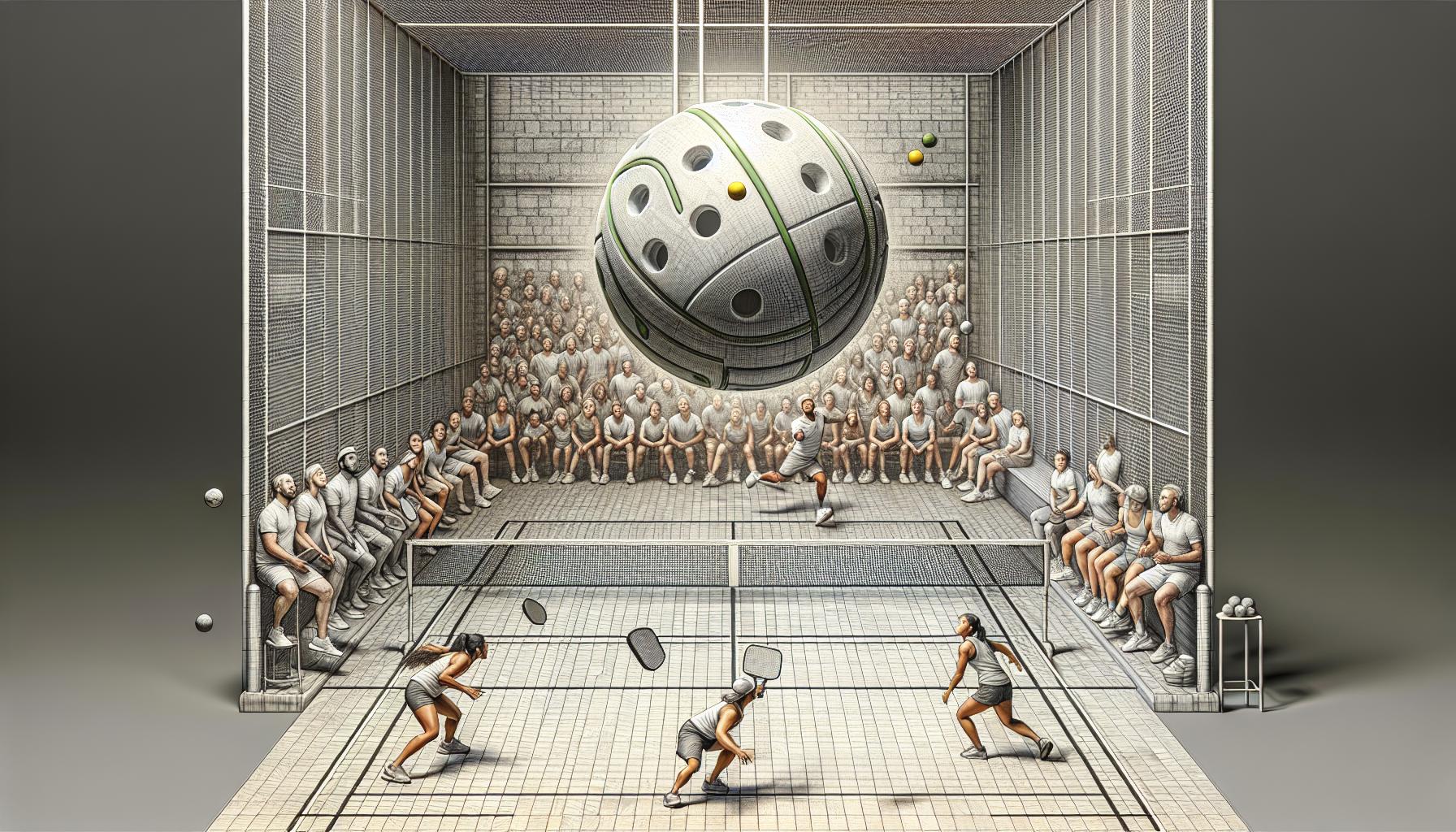In the fast-paced world of pickleball, understanding the rules can be as crucial as mastering the perfect serve. Among these rules, the concept of a “let serve” often pops up, leaving some players scratching their heads in confusion. What exactly makes a serve a let, and why does it matter?
Let serves in pickleball have their own set of criteria, distinguishing them from regular serves and faults. They’re like the game’s way of saying, “Let’s give that another try,” without penalizing the server. But what conditions must be met for a serve to be considered a let? Let’s dive into the specifics and shed some light on this intriguing aspect of pickleball.
Understanding Let Serves in Pickleball
In the dynamic world of pickleball, mastering the nuances of serving can significantly impact a player’s game. An essential aspect to familiarize oneself with is the let serve—a scenario that might not directly influence the score but can certainly affect the flow and strategy of the game. Understanding when and why a let serve occurs helps players not only adhere to the rules but also use them to their advantage.
A let serve in pickleball happens under specific conditions that allow the server to re-serve without facing a penalty. This scenario typically occurs when the served ball touches the net, lands in the correct service court, and is otherwise playable. Unlike in some other racket sports, where a net serve might automatically count as a fault or might have unlimited lets, pickleball puts a cap on how beneficial a let can be for the server.
Criteria for a Let Serve
To deepen the understanding, let’s delve into the precise criteria that dictate a let serve in pickleball. These are distinct points that every player should know:
- The served ball must touch the net. This is the primary condition that differentiates a let serve from a regular serve or a fault.
- The ball must land within the bounds of the diagonal service court. If the ball after touching the net goes out of bounds, it is considered a fault.
- The ball must not be caught or stopped by the server or their partner in doubles play before it lands. Any interference results in a fault.
It’s also noteworthy that a let serve does not count as a serve attempt. In other words, the server retains their opportunity to make a successful serve. This rule ensures fairness and keeps the game flowing without unnecessarily penalizing players for minor infractions.
Conditions Preventing a Let Serve
While the criteria above outline when a let serve is awarded, there are situations where a let serve will not be granted. These include:
- Server faults unrelated to the net, such as foot faults or serving before the receiver is ready.
- Ball striking an object after hitting the net but before landing in the service area.
- Serves that hit the net and land outside the bounds of the correct service court.
Understanding both the criteria for and the exceptions to let serves is vital for players aiming to compete fairly and effectively. This knowledge not only helps in avoiding unnecessary faults but also in developing strategies around the serve.
Criteria for a Let Serve

When playing pickleball, understanding the nuances of a let serve can significantly impact a player’s strategy and game flow. Let serves are unique opportunities, allowing a server a second chance under specific circumstances without facing a penalty. These conditions must be met precisely for a serve to be considered a let.
Firstly, a key condition for a let serve is that the ball must touch the net, tape, or cord during the serve and subsequently land within the correct bounds of the service court. This means the ball must fall into the diagonal box opposite the server without touching any permanent fixtures except the net. It’s crucial that the ball is not caught, stopped, or otherwise interfered with before it lands to qualify as a let serve.
Secondly, the serve must be free from any other faults for it to be considered a let. Faults include foot faults, where a player’s foot encroaches on the baseline or court lines during the serve, and instances where the ball hits an object or person outside of the court boundaries. If any faults occur simultaneously with the ball touching the net, the serve does not qualify as a let and normal fault rules apply.
Moreover, a distinction is made in that let serves do not count toward the server’s two allowed serve attempts in pickleball. This rule ensures that a player isn’t unfairly penalized for an uncontrollable factor like the ball lightly grazing the net. It maintains the game’s flow and fairness, allowing for a re-serve without it impacting the server’s count.
Understanding these criteria is crucial for both players and referees to ensure the game is played fairly and according to the rules. Players familiar with the specifics of what constitutes a let serve can better prepare for and react to these situations during gameplay. They’re able to maintain composure and focus on their strategy, knowing exactly when they’re granted another serve attempt.
In competitive play, the accurate identification of let serves becomes even more critical. Both players and officials must remain vigilant, keeping an eye on the ball’s trajectory and how it interacts with the net. Disputes can often arise around let serves, so having a clear understanding of the rules can help resolve conflict and keep the game moving smoothly.
Difference Between Let Serves and Faults

Understanding the crucial difference between let serves and faults in pickleball can significantly alter the course of the game. While both terms describe interruptions during gameplay, their implications and the subsequent actions taken by players diverge notably.
A let serve occurs when the ball makes contact with the net, tape, or cord during the serve but still lands within the proper service court. This play does not penalize the server; instead, it grants them another chance to serve without counting against their two permitted serve attempts. It’s an instance where the serve is neither successful nor a failure but falls somewhere in between, allowing for a retry.
In contrast, a fault is a serve or play that violates the rules of pickleball, leading to the loss of serving rights or a point awarded to the opposing team. Faults can occur in various scenarios, including:
- The ball hitting outside the appropriate service area.
- The ball not clearing the net.
- The server committing a foot fault by stepping on or across the baseline before hitting the ball.
- The served ball touches any object outside of the court before landing.
| Type | Scenarios | Outcome |
|---|---|---|
| Let Serve | Ball hits the net but lands within the correct service area. | Server gets another attempt. |
| Fault | Ball lands out of bounds, doesn’t clear the net, server foot faults, or ball hits an external object. | Loss of serve or point awarded to the opponent. |
For players, distinguishing between let serves and faults is essential for maintaining the flow of the game and harnessing strategic advantages. For instance, a player with a strong understanding of these rules can recalibrate their serving strategy on the fly if they frequently encounter let serves, ensuring they stay within the bounds of legal play while maximizing their serves’ effectiveness.
Moreover, for referees and officials, this knowledge aids in making swift, fair decisions that uphold the spirit and integrity of the game. As pickleball continues to grow in popularity, so does the scrutiny placed on the clarity and consistency of rule enforcement. By thoroughly grasifying and applying the distinctions between let serves and faults, players, referees, and fans alike can enjoy a more streamlined, competitive, and enjoyable gaming experience.
Handling Let Serves During Gameplay

When a let serve occurs in pickleball, players need to immediately recalibrate their focus and prepare for the ball to be served again. Unlike faults, which can halt the momentum and switch the advantage to the opposing team, let serves merely pause the action momentarily. This pause requires players to maintain their concentration and be ready to quickly reengage in play.
One essential aspect of handling let serves efficiently is for players to stay alert and adaptable. Given that the server gets another opportunity without penalty, the receiving team must not allow this brief interruption to disrupt their strategy or readiness. Adaptability and quick reflexes are key, as the flow of the game can resume swiftly after a let serve.
Communication between team members also plays a pivotal role during these moments. In doubles play, for instance, partners need to quickly confirm their positions and ensure they are covering the expected areas of the court. This team coordination can be the difference between successfully returning the subsequent serve or being caught off guard.
Practicing scenarios that involve let serves can help players and teams to better manage these occurrences during competitive play. Drills that simulate let serves can improve reaction times, enhance strategic planning, and build a mutual understanding between team members on how to handle these situations effectively. This preparation can significantly mitigate the potential disruption let serves might cause.
Moreover, understanding the nuances of the rules regarding let serves is crucial for all involved in the game. Players, coaches, and referees alike must be familiar with what constitutes a let serve and how it should be correctly handled following pickleball regulations. This knowledge ensures that games are played fairly and according to the official standards, maintaining the integrity of the sport.
Players should also be aware of the psychological aspect of let serves. A let serve can sometimes be seen as a second chance for the server to perfect their serve, potentially putting additional pressure on the receiving player or team. Staying mentally strong and viewing it as another opportunity to showcase defensive skills can help players handle let serves more effectively.
In competitive matches, the frequency of let serves can vary, but each one presents an opportunity for teams to demonstrate their preparedness and resilience. Whether it’s a casual game among friends or a high-stakes tournament, effectively managing let serves can greatly influence the overall performance and outcome of the match.
Common Misconceptions about Let Serves

In the realm of pickleball, let serves often become a topic of heated discussions and misunderstandings. Despite being a foundational aspect of the game, there are several misconceptions that can confuse players, from beginners to the more experienced. Addressing these myths is crucial for everyone’s understanding and appreciation of the game.
One of the most prevalent myths is that a let serve in pickleball is similar to those in tennis, where the serve, if hitting the net and still landing in the appropriate service box, is simply replayed. In pickleball, the rule has nuances that can catch players off guard. Specifically, a serve that lightly grazes the net but lands in the correct service area is considered in play and not a let. This distinction underscores the game’s emphasis on continuous play and quick reflexes.
Another common misunderstanding revolves around the frequency of let serves. Some players believe that let serves are rare occurrences in the game. However, as play intensifies and serves become more strategic, the instance of let serves can increase, especially in competitive environments. This increase underscores the need for players to always stay alert and ready for the unexpected.
There’s also a widespread belief that let serves disadvantage the serving team. In reality, they can turn into strategic advantages if handled correctly. Teams that practice and prepare for let serve scenarios can use them to catch their opponents off guard, turning a potentially disruptive moment into an opportunity for scoring.
| Misconception | Reality |
|---|---|
| Let serves are the same in pickleball as in tennis. | Pickleball let serves have unique rules, emphasizing continuous play. |
| Let serves are rare. | Their frequency can increase in competitive play. |
| Let serves disadvantage the serving team. | With preparation, they can provide strategic advantages. |
Moreover, many players are under the impression that any ball touching the net post on a serve automatically constitutes a let. This is not the case; in pickleball, if a serve hits the net post and lands in the correct service area, it is deemed out of play. Knowing the exact rules regarding net posts and serve validity is essential for accurate gameplay and fair judgment calls.
Conclusion
Grasping the nuances of let serves in pickleball is essential for players who wish to excel and enjoy the game to its fullest. By dispelling common misconceptions, players can approach each serve with the right mindset and strategy. It’s not just about staying alert; it’s also about turning unexpected moments into opportunities. Remember, the game’s unique rules around let serves are there to enhance the pace and excitement of pickleball. So next time you’re on the court, keep these insights in mind and let them guide your play. After all, understanding the rules is the first step to mastering the game.














0 Comments